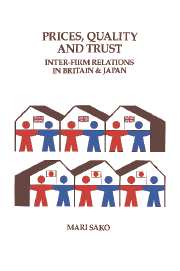Book contents
- Frontmatter
- Contents
- List of figures
- List of tables
- Acknowledgements
- Introduction
- Part I Theory and concepts
- 1 A spectrum of transactional patterns: from ACR to OCR
- 2 Trust and organisational efficiency
- Part II Case studies and survey
- Part III Explanations of variations
- Part IV Outcomes and implications
- Appendix
- Notes
- Bibliography
- Index
1 - A spectrum of transactional patterns: from ACR to OCR
Published online by Cambridge University Press: 30 October 2009
- Frontmatter
- Contents
- List of figures
- List of tables
- Acknowledgements
- Introduction
- Part I Theory and concepts
- 1 A spectrum of transactional patterns: from ACR to OCR
- 2 Trust and organisational efficiency
- Part II Case studies and survey
- Part III Explanations of variations
- Part IV Outcomes and implications
- Appendix
- Notes
- Bibliography
- Index
Summary
This chapter sets out the conceptual framework to be employed throughout this book. Central to the framework are the two patterns, Arm's-length Contractual Relation (ACR) and Obligational Contractual Relation (OCR), which represent the ends of a multi-dimensional spectrum of possible trading relationships. First, the basic features of ACR and OCR are described. Second, major assumptions underlying the ACR—OCR patterns are made explicit. Third, socio-economic factors which may account for ACR—OCR variations are identified. Fourth, implications of ACR—OCR patterns for performance are examined. Lastly, the chapter discusses how the ACR—OCR framework relates to Williamson's transaction cost theory.
Defining ACR and OCR
The Arm's-length Contractual Relation (ACR) involves a specific, discrete economic transaction. An explicit contract spells out before trading commences each party's tasks and duties in every conceivable eventuality, as far as human capacity for anticipation allows. If unforeseen contingencies arise, they are settled by resort to some universalistic legal or normative rules. All dealings are thus conducted at arm's length, to avoid undue familiarity, with neither party controlled by the other. Consequently, seeking an alternative trading partner (‘exit’ in Hirschman's (1970) terms) is an easily available option when a contract comes to an end.
The Obligational Contractual Relation (OCR) also involves an economic contract covering the production and trading of goods and services.
Information
- Type
- Chapter
- Information
- Price, Quality and TrustInter-firm Relations in Britain and Japan, pp. 9 - 29Publisher: Cambridge University PressPrint publication year: 1992
Accessibility standard: Unknown
Why this information is here
This section outlines the accessibility features of this content - including support for screen readers, full keyboard navigation and high-contrast display options. This may not be relevant for you.Accessibility Information
- 1
- Cited by
